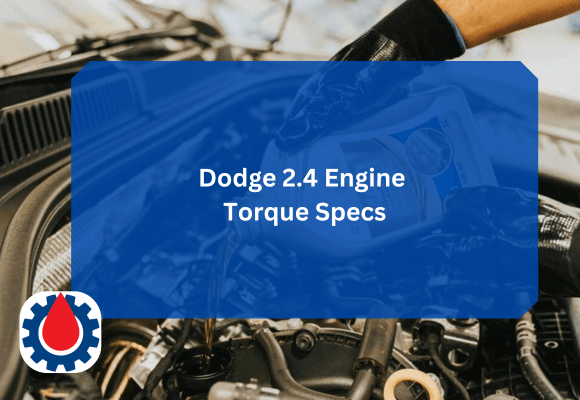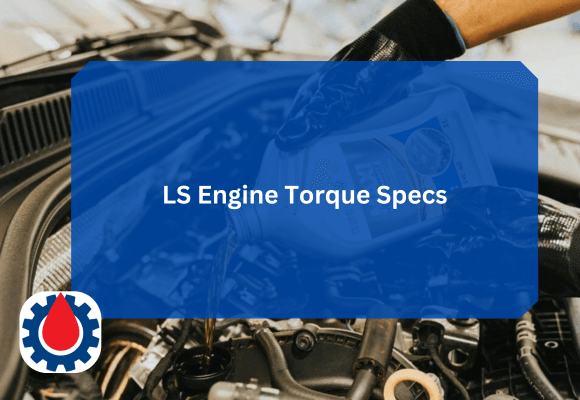This guide covers the most important Dodge 2.4L engine torque specs, including cylinder head bolts, main caps, rod bolts, spark plugs, and other critical fasteners. While minor variations exist between model years, the torque values below accurately represent the most common specs used in 2.4L Dodge/Chrysler engines, especially the 2.4L DOHC and 2.4L World Engine platforms.
Dodge 2.4 Engine Torque Specs
| Component | Torque Specification |
|---|---|
| Cylinder Head Bolts | Step 1: 20 ft-lbs |
| Step 2: 40 ft-lbs | |
| Step 3: +90° turn | |
| Step 4: +90° turn (Torque-to-yield bolts — must replace) | |
| Camshaft Cap Bolts | 105 in-lbs (≈ 9 ft-lbs) |
| Camshaft Sprocket Bolts | 75 ft-lbs |
| Main Bearing Cap Bolts | 70 ft-lbs + 90° |
| Connecting Rod Bolts | 20 ft-lbs + 70° |
| Crankshaft Damper Bolt | 125 ft-lbs |
| Intake Manifold Bolts | 105 in-lbs |
| Exhaust Manifold Bolts | 250 in-lbs (≈ 21 ft-lbs) |
| Oil Pan Bolts (Upper) | 18 ft-lbs |
| Oil Pan Bolts (Lower) | 105 in-lbs |
| Valve Cover Bolts | 105 in-lbs |
| Spark Plugs | 13–15 ft-lbs |
| Flywheel/Flexplate Bolts | 60 ft-lbs |
| Water Pump Bolts | 105 in-lbs |
| Thermostat Housing Bolts | 105 in-lbs |
Related SBC Engine Torque Specs(For All Components)
Cylinder Head Torque Procedure Explained
One of the most important torque processes on the Dodge 2.4 engine is the cylinder head. This engine uses torque-to-yield (TTY) head bolts, meaning the bolts stretch during installation and cannot be reused.
The correct tightening method is:
- Torque all bolts to 20 ft-lbs
- Torque all bolts to 40 ft-lbs
- Turn all bolts 90°
- Turn all bolts another 90°
It’s crucial to follow the sequence, usually starting from the center and working outward in a spiral pattern. Incorrect torque or improper sequence often leads to blown head gaskets or warped heads.
Related Engine Torque Calculator
Main Bearing and Rod Bolt Torque Specs
The bottom end of the 2.4L engine relies on precise torque values to maintain oil clearance and prevent bearing failure.
Main Cap Bolts
- 70 ft-lbs + 90° turn
Because these bolts also use an angle-torque method, applying torque in stages ensures even clamping and helps prevent crankshaft distortion.
Rod Bolts
- 20 ft-lbs + 70° turn
Rod bolts are one of the most stressed fasteners in the engine. Under-torquing can cause rod knock, while over-torquing may stretch the bolt and weaken it.
Timing Component Torque Specs
Correct torque on timing components ensures proper belt tension and long-term reliability.
Camshaft Sprocket Bolts
- 75 ft-lbs
Timing Belt Tensioner Bolts
- 250 in-lbs (≈ 21 ft-lbs)
Following these values helps prevent belt slip, misfires, and costly engine damage.
Related CC to Hp Calculator
Intake, Exhaust, and Accessory Torque Specs
Although these fasteners are less critical than the head or rod bolts, correct torque prevents air leaks, exhaust leaks, and poor engine performance.
- Intake manifold: 105 in-lbs
- Exhaust manifold: 250 in-lbs
- Valve cover: 105 in-lbs
- Water pump: 105 in-lbs
- Thermostat housing: 105 in-lbs
Keep in mind: overtightening aluminum components can easily strip threads.
Spark Plug Torque for the Dodge 2.4 Engine
Proper spark plug torque is vital, especially with aluminum cylinder heads.
- Spark plug torque: 13–15 ft-lbs
Over-torquing may damage the threads, while under-torquing can cause blowout or misfire.
Related 18 HP Briggs and Stratton Engine Torque Specs
FAQs
What is the torque specs of a 2.4 mm connector?
A 2.4 mm RF connector (commonly used in high-frequency microwave applications) typically requires 5–8 in-lbs of torque. Always use a calibrated torque wrench designed for RF connectors to avoid damaging the threads or affecting signal performance.
How much horsepower does a 2.4 Dodge engine have?
The Dodge 2.4L engine generally produces 150–180 horsepower, depending on the model year, vehicle, and whether it’s the standard 2.4L DOHC or the 2.4L World Engine. Turbocharged variants, such as the Dodge Caliber SRT4 2.4L Turbo, produce 285+ horsepower.
What is the torque sequence for the head bolts on a 2.4 L Ecotec?
The 2.4L Ecotec head bolt torque sequence starts from the center bolts and moves outward in a spiral pattern. This ensures even head clamping. While exact values vary, the typical Ecotec head bolt procedure is:
- Torque to 22 ft-lbs
- Turn 90°
- Turn 90° again.
(Always consult the vehicle-specific service manual for the exact pattern and steps.)
What is the torque setting for cylinder head bolts?
Cylinder head bolt torque varies by engine, but most modern engines, including Dodge 2.4L, Chevy Ecotec, Toyota, Honda, and others, use torque-to-yield (TTY) bolts. These usually follow a multi-step process, such as:
- First stage: 20–30 ft-lbs
- Second stage: 40–50 ft-lbs
- Final stages: Two 90° turns
TTY bolts must be replaced after removal.
What are the torque specifications for bolts?
Torque specifications depend on bolt size, grade, and application. In general:
- Small bolts (6–8 mm): 80–120 in-lbs
- Medium bolts (10–12 mm): 20–45 ft-lbs
- Large bolts (14–16 mm): 60–100 ft-lbs
- Critical engine bolts (mains, rods, head): Often use torque + angle (e.g., 40 ft-lbs + 90°)
Final Tips for Working on the Dodge 2.4 Engine
- Always replace TTY bolts (especially head bolts).
- Use a calibrated torque wrench.
- Clean threads before installation.
- Torque bolts in steps.
- Follow the official service manual torque sequences.




